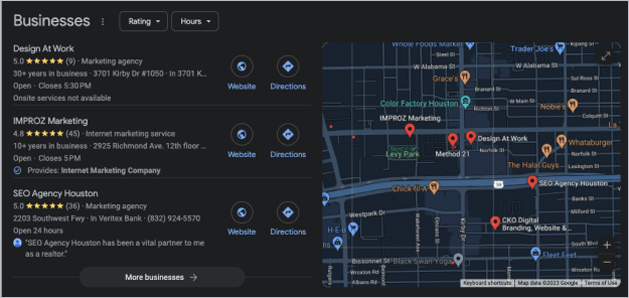A guide to best practices for local
search engine optimization.

Search engines have revolutionized the way we navigate and engage with our communities. If you find yourself in need of an oil change or craving a hot chicken sandwich, chances are your first move will be to search Google for the best options near you. The results of your query depend on something called local search engine optimization (SEO). It’s a technique businesses can use to make it easier for customers to find them online, thereby boosting foot traffic, website engagement and, ultimately, sales.
We’ve compiled three essential tips that will help you make the most of local SEO opportunities. But first, let’s cover the basics.
What Is Local SEO?
Local SEO is a way of enhancing your company’s online presence. A solid local SEO strategy can increase visibility and traffic, promote brand awareness and strengthen your reputation. If you have a brick-and-mortar location or serve a limited geographic region, it’s well worth the effort to optimize for local search results.

How Does Local SEO Work?
Like all SEO tactics, local SEO relies heavily upon keyword research, which is the process of investigating how users search for your product or service. These keywords can be used to create high-quality content on your website that Google can index and then serve up to customers when they’re in the market for your offerings.
But your website is only one piece of the local SEO puzzle. It’s also essential to claim and optimize your Google Business Profile and manage your online reputation by monitoring and responding to reviews across a variety of platforms. With thoughtful planning and regular maintenance, you can ensure customers find your business — and like what they see when they do.
The following tips will help propel you to local SEO success.
1. Set Up and Optimize Your Google Business Profile.

If you haven’t already claimed your Google Business Profile, start by searching for your business. If it’s already listed on Google Maps, you can submit your information and request access to the profile. The verification process differs across industries and regions, but may include submitting a code received by postcard at your physical address, sending photos of your business or engaging in a face-to-face video chat with a Google representative. This handy guide explains how to add or claim your Business Profile on Google.
Once your profile has been verified, it’s time to optimize it. First, you’ll want to choose from about 4,000 business categories. Select a category that both accurately describes your enterprise and reflects popular search queries. For example, if you’re a residential building company, you could choose from “Home Builder,” “Custom Home Builder,” or even “General Contractor.” Tools like Semrush can help you narrow down your keyword options.
After selecting the best category, you can further optimize your profile by adding photos, operating hours, service areas, a description of your business and, of course, your address and phone number. Keep in mind that your name, address and phone number (NAP) should be consistent across the web. NAP consistency helps customers find and recognize your business.
You can also post content to your Google Business Profile as you would on any other social platform. Sharing photos, promotional materials and event information adds interest to your profile and encourages customer engagement. The latter constitutes a crucial component of local SEO strategy.

2. Manage Your Online Reputation.

We all know how helpful (or devastating) online reviews can be. If you’re searching for a restaurant in your area, you’ll probably think twice before patronizing an establishment with a heavy percentage of negative reviews. While you can’t control how users rate your business online, you can mitigate unwanted impacts by monitoring and responding positively to reviews (even the critical ones).
Set up a regular process to check for customer feedback on sites like Yelp, Facebook and Glassdoor. The particular platforms you’ll want to monitor depend on your business and industry. If you come across a glowing review — great! Let the user know you appreciate their comment. If an unhappy customer voices disappointment, apologize, reiterate your commitment to customer service and offer to make the situation right, either by providing a refund or reviewing your internal processes.
You can’t expunge negative reviews from your record, but you can strengthen your reputation by being kind, helpful and sincere. Doing so can lessen the effects of a poor rating and encourage prospective customers to ignore the critical feedback.
3. Track Your Local SEO Performance.

In addition to reputation management, it’s important to keep an eye on your performance in search results. You can run regular audits or even set up a tracking campaign to observe how your local keywords perform over time. Pay attention to your performance in target areas, as well as the types of devices customers use to search for you. Semrush offers a Listing Management Heatmap that can help you monitor your rankings and visibility in key areas within your service radius.
You can also compete for featured snippets in Google. Landing a spot in a local pack or image carousel will dramatically increase your visibility to potential customers. You can set up a dedicated filter in your SEO tracking platform, or simply enter your target keywords periodically to see if you’ve reached snippet status.

Ready to attract prospects and boost sales with local SEO? We can help! Contact us to learn more about this powerful technique.
Marketing Emails You’ll Actually Want To Read.
Get marketing tips and news sent to your inbox.


